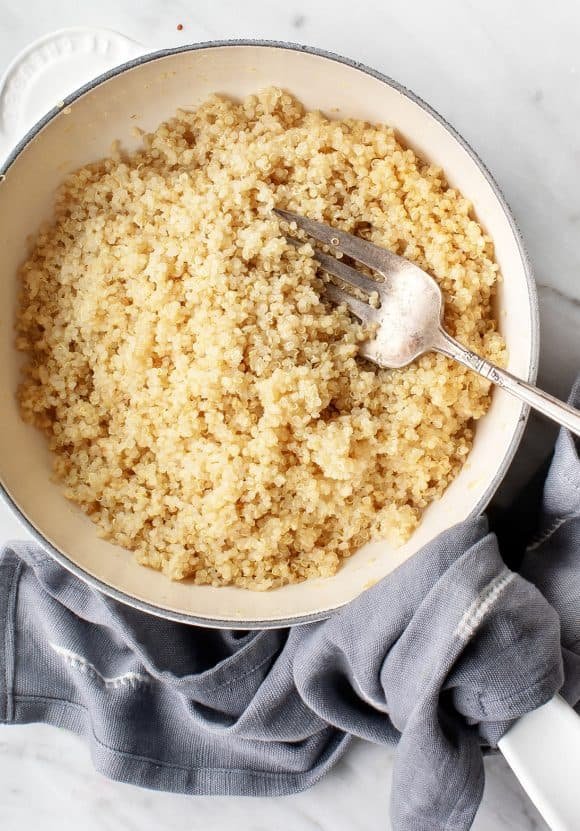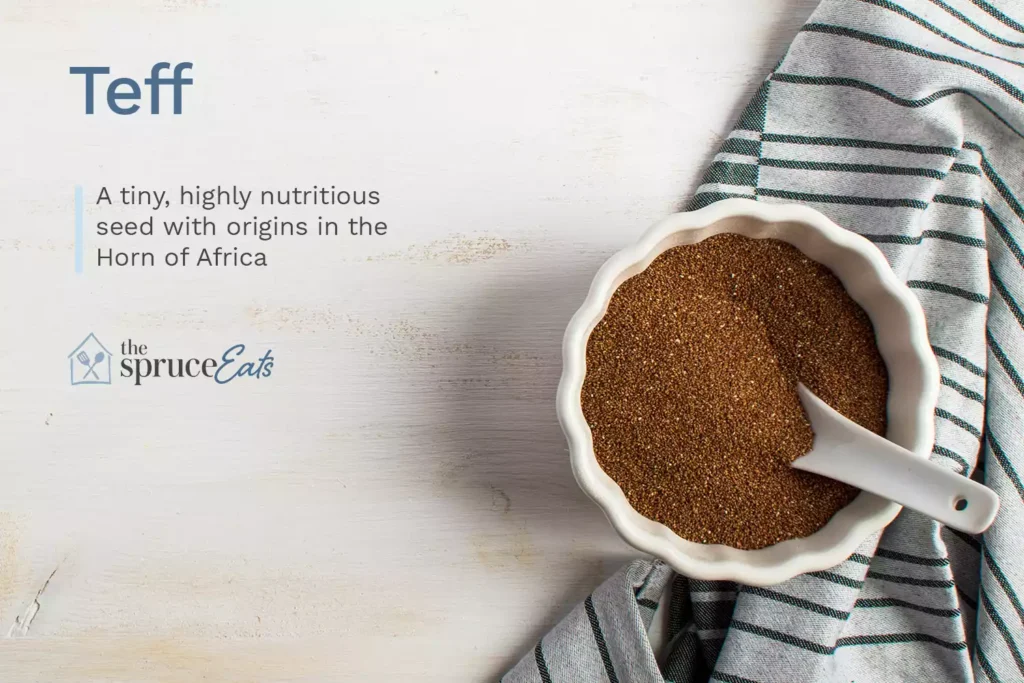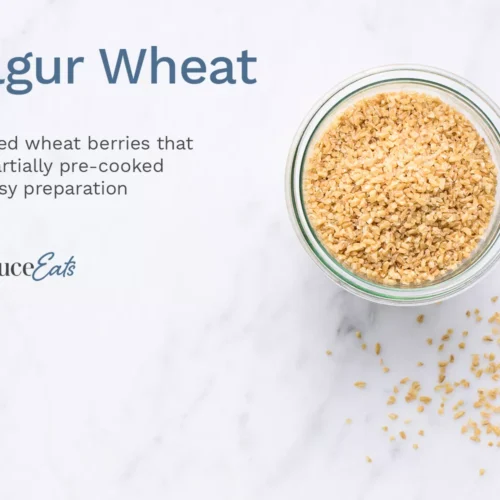Are you looking for a delicious, nutritious alternative to bulgur?
Bulgur is a popular grain that is made from wheat berries and is used in many traditional Middle Eastern dishes.
It has a nutty flavor and chewy texture that makes it an excellent addition to salads, pilafs, stews, and more.
Unfortunately, not everyone can tolerate or enjoy bulgur due to allergies or dietary restrictions.
If this sounds like you, don’t worry – there are plenty of tasty alternatives out there!
In this article, I’ll be discussing the 15 best substitutes for bulgur so that you can still enjoy your favorite recipes without missing out on any of the flavor.
What is Bulgur?

Bulgur is a whole-grain product made from parboiled wheat berries.
The wheat berries are dried and coarsely ground into small particles that resemble cracked wheat.
Bulgur has a nutty, earthy flavor and can be used in many recipes as an alternative to rice or couscous.
Bulgur is widely available in supermarkets and health food stores, usually packaged in boxes or bags.
It cooks up quickly, with boiling water often the only requirement for use.
The cooked bulgur can be enjoyed on its own as a hot cereal, added to soups and stews for extra texture, shaped into burgers or meatballs, stirred into salads for additional protein and fiber content, or even used as stuffing for poultry dishes.
The 15 Best Substitutes For Bulgur
Bulgur is a nutritious and delicious grain that can be difficult to find in some areas.
Fortunately, there are many other grains that can make great substitutes for bulgur.
Here are fifteen of the best alternatives:
1 – Quinoa

Quinoa is a versatile and nutritious grain that can be used as an excellent substitute for bulgur.
Quinoa is high in protein, fiber, vitamins, minerals, and antioxidants.
It also has a mild nutty flavor and slightly chewy texture that makes it a great substitution for bulgur in many recipes.
It can be cooked like rice or boiled to make a delicious side dish or salad base.
Quinoa also works well in soups and stews as it absorbs the flavors of the broth while still retaining its shape.
For example, you could use quinoa instead of bulgur when making tabbouleh salad or kibbeh balls.
You could also replace bulgur with quinoa in pilafs or stuffed peppers for added nutrition and texture.
2 – Rice

Rice is a versatile grain that can be used as an alternative to bulgur in many recipes.
White rice has a mild flavor and fluffy texture, while brown rice has a nuttier taste and chewier consistency.
Rice is perfect for making pilafs, salads, soups, or stuffing vegetables.
It can also be cooked with other ingredients like beans or vegetables to make flavorful one-pot meals.
For example, you could make Mexican Rice by sautéing onion and garlic in olive oil before adding long-grain white rice and cooking until it’s lightly golden.
Then add diced tomatoes, chili powder, cumin, oregano, bay leaves and chicken broth before bringing the mixture to a boil.
Cover the pot and simmer until the liquid is absorbed then fluff with a fork before serving.
You could also try making Indian-style Coconut Rice by heating up some coconut oil in a pan then adding basmati rice along with mustard seeds, curry leaves and shredded coconut before stirring and cooking on low heat.
Once the rice is cooked, add some cilantro and lime juice before serving with your favorite curry.
From pilafs to curries, rice is an incredibly versatile grain that can be used to make a variety of delicious dishes.
3 – Wheat Couscous

Wheat couscous is a type of pasta made from semolina flour and water.
It has a light, fluffy texture and mild flavor that makes it great for salads or as a side dish.
Wheat couscous can be used as an alternative to bulgur in many recipes, such as tabbouleh, pilafs, soups, stews, and even desserts.
For example, you could use wheat couscous instead of bulgur in your favorite tabbouleh recipe by simply replacing the bulgur with cooked wheat couscous.
The end result will be just as delicious!
You could also substitute wheat couscous for bulgur in a hearty winter soup or stew by cooking the wheat couscous separately before adding it to the pot at the end of cooking time.
This will give your soup or stew an extra boost of flavor and texture without sacrificing any nutritional value.
Finally, you can even use wheat couscous to make sweet treats like puddings and desserts.
Simply cook the wheat couscous in milk, add a few sweeteners, and top with your favorite fresh fruit or nuts for a delicious and healthy treat.
4 – Buckwheat

Buckwheat is a nutritious, gluten-free grain that can be used as an alternative to bulgur.
It has a nutty flavor and chewy texture that makes it perfect for salads, pilafs, and even breakfast porridge.
Buckwheat is high in fiber and protein, making it a great choice for those looking to add more plant-based nutrition into their diet.
To use buckwheat instead of bulgur in recipes, simply cook the buckwheat according to package directions before adding it to the dish.
For example, you could make a warm buckwheat salad with roasted vegetables or create a savory buckwheat risotto with mushrooms and herbs.
You could also try your hand at making traditional Russian blini pancakes using cooked buckwheat groats as an alternative to bulgur wheat.
5 – Millet

Millet is a highly nutritious grain that has been enjoyed for centuries in many parts of the world.
It is high in fiber, protein, and essential minerals like iron, magnesium, and zinc.
The flavor of millet is mild and slightly nutty with a light texture that makes it ideal for use in pilafs or as an alternative to couscous or bulgur.
Millet can also be used as a replacement for bulgur when making tabbouleh salad – just add some diced tomatoes, cucumbers, mint leaves, lemon juice, olive oil and salt to cooked millet for a delicious Mediterranean-style dish.
For breakfast porridge fans out there, try swapping your usual oats for cooked millet instead – simply mix with milk (or plant-based milk) and sweetener of choice before topping with fresh fruit or nuts.
6 – Cracked Wheat

Cracked wheat is a great alternative to bulgur, as it has a similar texture and nutty flavor.
It is made by grinding whole wheat grains into smaller pieces that are then cooked like rice.
The result is a chewy grain with an earthy taste that can be used in many recipes.
For example, cracked wheat can be used to make pilafs, salads, or even burgers.
It’s also great for adding texture and nutrition to soups and stews.
One of the best ways to enjoy cracked wheat is in tabbouleh – a Mediterranean salad made from chopped parsley, tomatoes, onions, mint leaves, olive oil, lemon juice and spices.
Another delicious way to use cracked wheat is in kibbeh – an Arabic dish consisting of ground beef or lamb mixed with burghul (cracked wheat) and spices such as cumin and cinnamon.
7 – Wheat Berries

Wheat berries are a whole grain with a chewy texture and nutty flavor.
They’re the unprocessed form of wheat kernels, which can then be cracked or ground into flour.
Wheat berries make an excellent replacement for bulgur in recipes such as tabbouleh, salads, pilafs, and soups.
To prepare wheat berries, they should be soaked overnight before cooking them in boiling water or broth until tender (about 30 minutes).
They can also be cooked in a slow cooker or pressure cooker to save time.
Once cooked, they can be used in place of bulgur in dishes like Mediterranean-style salads with feta cheese and olives; curried lentil soup; and mushroom barley risotto.
8 – Kamut

Kamut is an ancient grain that has been used in Middle Eastern and Mediterranean cuisines for centuries.
It is high in protein, fiber, vitamins, minerals, and essential fatty acids.
Kamut has a nutty flavor and chewy texture that makes it perfect for salads, pilafs, soups, stews, or as a side dish.
When substituting kamut for bulgur wheat in recipes like tabbouleh or kibbeh nayyeh (a popular Levantine dish), you may need to adjust the cooking time since kamut takes longer to cook than bulgur.
To make a delicious Kamut Pilaf with vegetables: heat oil in a large skillet over medium-high heat; add diced onion and saute until softened; stir in garlic and spices of choice; add diced carrots and celery; cook until tender; stir in cooked kamut grains; season with salt and pepper to taste; serve warm.
9 – Farro

Farro is an ancient grain with a nutty flavor and chewy texture.
It is high in fiber, protein, and minerals like iron, magnesium, and zinc.
Farro can be used as a substitute for bulgur in many recipes, such as tabouli salad or pilafs.
When cooked properly it can provide a delicious alternative to traditional bulgur wheat.
To prepare farro for cooking, rinse the grains under cold running water before boiling them in salted water until they are tender but still have some bite to them.
Once cooked you can use farro much like you would with bulgur – add it to salads or soups, mix it into stuffings or casseroles, or even serve it as a side dish topped with vegetables and herbs.
Farro is also great for making risotto-like dishes – simply sauté the grains in butter before adding liquid and simmering until creamy.
10 – Barley

Barley is a nutritious and versatile grain that can be used in place of bulgur.
It has a nutty flavor and chewy texture, making it great for salads, soups, stews, risottos, and pilafs.
Barley is packed with fiber and B vitamins to help keep you full longer.
It also contains minerals like magnesium and iron.
To use barley instead of bulgur in recipes, simply substitute equal amounts of the two grains.
Barley does take longer to cook than bulgur though – about 45 minutes compared to 15-20 minutes for bulgur – so plan accordingly!
Some delicious recipes where barley can be substituted for bulgur include Mediterranean barley salad with feta cheese, roasted vegetable barley risotto, slow cooker beef stew with pearl barley, or mushroom barley soup.
11 – Orzo

Orzo is a type of pasta that looks like grains of rice, making it an excellent replacement for bulgur.
It has a slightly nutty flavor and chewy texture that works well in salads, soups, and casseroles.
Orzo can be cooked quickly on the stovetop with just a few minutes of boiling time – no need to soak it beforehand like you would with bulgur.
Plus, orzo is incredibly versatile and can be used as the base for many dishes, such as Greek Orzo Salad or Mediterranean Orzo Bowls.
For an easy weeknight dinner, try replacing your usual bulgur with orzo in recipes like stuffed peppers or tabbouleh.
The results will be delicious!
12 – Bamboo Rice
https://www.pinterest.com/pin/481814860146525358/Bamboo rice is a unique type of grain that has been cultivated in Asia for centuries.
It has a mild, nutty flavor and chewy texture that makes it an excellent substitute for bulgur.
The grains are small and round, with a light yellow hue when cooked.
Bamboo rice can be used as an alternative to bulgur in many recipes, such as pilafs, salads, soups, and stir-fries.
It can also be added to breakfast bowls or smoothies for extra nutrition.
For example, you could make a savory Bamboo Rice Pilaf by sautéing onions and garlic before adding the bamboo rice and vegetable broth.
Simmer until the liquid is absorbed before stirring in herbs like parsley or thyme for extra flavor.
You could also use it to make a delicious Bamboo Rice Salad by combining cooked bamboo rice with vegetables like bell peppers or tomatoes along with your favorite dressing or vinaigrette.
13 – Amaranth

Amaranth is a gluten-free grain that has been used in Central and South American cuisine for centuries.
It is high in protein, minerals, and fiber, making it an excellent alternative to bulgur.
Amaranth has a nutty flavor with a slightly sweet aftertaste.
It can be cooked like rice or boiled until tender and then served as a porridge.
It also makes an ideal base for salads or side dishes when combined with vegetables, herbs, nuts, and seeds.
For example, you could make amaranth tabbouleh by combining cooked amaranth with chopped parsley, tomatoes, cucumber, mint leaves, olive oil and lemon juice; or try adding it to your favorite stir-fry recipes for added texture and nutrition.
Amaranth can even be popped like popcorn for a delicious snack!
14 – Teff

Teff is a tiny, gluten-free grain with a nutty flavor and chewy texture.
It is high in protein, calcium, iron, and fiber – making it an excellent alternative to bulgur.
This ancient grain has been used for centuries in Ethiopian cuisine as the main ingredient in injera bread.
When cooked, teff swells up and becomes creamy like porridge or risotto.
It can also be ground into flour for baking or used as a substitute for bulgur in salads or side dishes.
For example, you could use teff instead of bulgur to make tabbouleh salad by mixing it with chopped parsley, tomatoes, cucumbers, and lemon juice.
You could also try substituting teff for bulgur when making veggie burgers or falafel patties.
Teff is an easy way to add nutrition and flavor to your meals without sacrificing taste!
15 – Shelled Hemp Seeds

Shelled hemp seeds are a great alternative to bulgur for those looking to add more plant-based protein and healthy fats into their diets.
The small, nutty-tasting seeds can be eaten raw or cooked, adding a crunchy texture and subtle flavor to any dish.
They’re also high in dietary fiber which helps keep you feeling full longer.
Shelled hemp seeds can be used as a substitute for bulgur in salads, soups, stews or grain bowls.
Try adding them to your favorite stir fry recipe for extra texture and nutrition or sprinkle them over oatmeal or yogurt for an added boost of protein.
Conclusion
In conclusion, bulgur is a versatile and nutritious ingredient, but if you don’t have it on hand, there are plenty of other grains and seeds that can be used as a substitute.
Some of the best substitutes for bulgur include quinoa, rice, wheat couscous, buckwheat, millet, cracked wheat, wheat berries, kamut, farro, barley, orzo, bamboo rice, amaranth, teff, and shelled hemp seeds.
All of these ingredients have a similar texture and flavor profile to bulgur, so you can substitute them in your recipes without sacrificing taste or nutrition.
Using these substitutes allows you to explore a variety of grains and seeds and create delicious dishes with a unique flavor profile.

The 15 Best Substitutes For Bulgur
Ingredients
- Quinoa
- Rice
- Wheat Couscous
- Buckwheat
- Millet
- Cracked Wheat
- Wheat Berries
- Kamut
- Farro
- Barley
- Orzo
- Bamboo Rice
- Amaranth
- Teff
- Shelled Hemp Seeds
Instructions
- Pick your favorite substitute from the list above.
- Follow cooking directions for your selected substitute with the proper ratio of ingredients.
Hi, I'm Benjamin. I love cooking, long walks, and my girlfriend! Here you’ll find simple and delicious recipes that you can make in 30 minutes or less.

